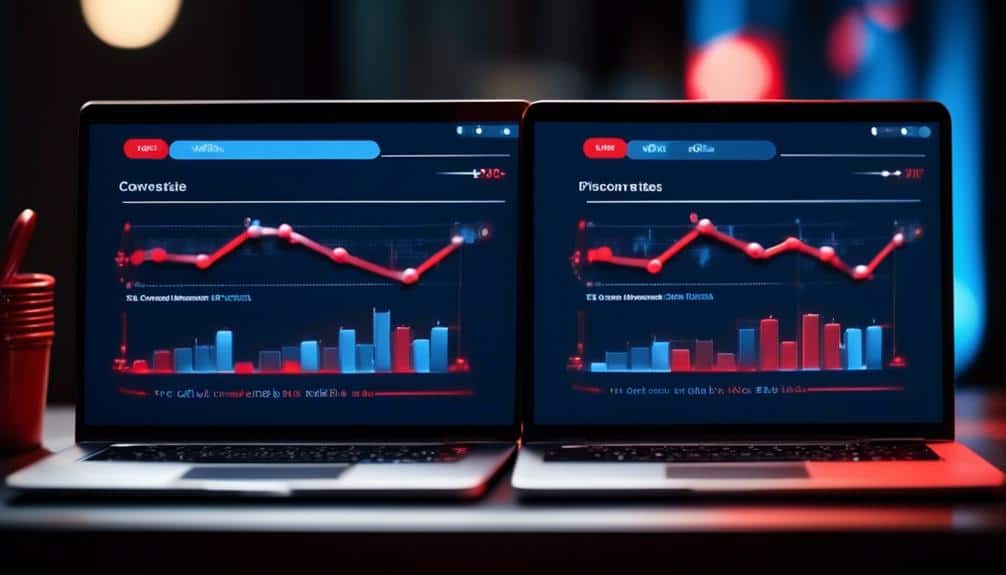A/B Testing Your Way to CTA Success: Strategies for Data-Driven Optimization
When it comes to enhancing the performance of your Call-to-Action (CTA) elements, employing a methodical approach can yield significant improvements.
By utilizing A/B testing, you can strategically refine your CTAs to drive better outcomes.
But, the real key lies not just in conducting these tests but in deciphering the valuable insights they uncover.
As you navigate the labyrinth of data-driven optimization, a systematic breakdown of strategies awaits that can propel your CTAs to new levels of success.
Key Takeaways
- Regular A/B testing optimizes conversion rates
- Analyzing A/B test results aids in decision-making
- Implementing successful CTA changes enhances user experience
- Utilizing heatmaps for insights improves CTA performance
Importance of A/B Testing for CTAs

Regularly conducting A/B testing for your Call-to-Action (CTA) buttons is crucial for optimizing conversion rates on your website. The color, placement, size, and wording of your CTA buttons can significantly impact user experience and ultimately influence conversion rates. Through A/B testing, you can experiment with different variations of your CTAs to determine which ones resonate best with your audience.
One key element to consider when A/B testing your CTAs is the button color. Different colors can evoke different emotions and responses from users. By testing various color options, you can pinpoint which color scheme elicits the highest conversion rates. Additionally, the language used in your CTAs plays a crucial role in attracting and engaging users. A slight tweak in wording can make a substantial difference in conversion rates.
Choosing Variables for CTA Testing
When optimizing your CTAs through A/B testing, the next critical step is to carefully select the variables to test for maximum impact on conversion rates. Two key variables that can significantly influence the effectiveness of your Call-to-Action (CTA) are CTA color and button placement. By experimenting with these variables in A/B tests, you can gain valuable insights into what resonates best with your audience and drives higher engagement.
Consider the following table as a guide for choosing variables for CTA testing:
| Variable | Description |
|---|---|
| CTA Color | Test different colors to see which attracts more attention and prompts action. |
| Button Placement | Experiment with placing the CTA button in various locations on the page to determine the most effective placement for conversions. |
Analyzing A/B Test Results

To effectively assess the outcomes of A/B tests, meticulously scrutinize the data to unveil patterns and insights that inform strategic decisions for enhancing CTA performance. When interpreting results, it's crucial to focus on statistical significance. This statistical measure helps determine if the differences observed in the test are due to actual effects or just random chance.
Start by examining key metrics such as conversion rates, click-through rates, or bounce rates. Identify which variations performed better and if the results are statistically significant. Statistical significance indicates the likelihood that the observed differences are real and not merely coincidental.
Dig deeper into the data to understand user behavior and preferences. Look for trends or patterns that emerge across different segments of your audience. By analyzing A/B test results with a keen eye for statistical significance, you can make informed decisions on which CTAs to implement for optimal performance. Remember, data-driven insights pave the way for continuous improvement and innovation in your CTA strategies.
Implementing Successful CTA Changes
Examining the successful CTA changes requires a keen understanding of the data patterns identified in the A/B test results to drive strategic improvements in user engagement and conversion rates. To implement successful CTA changes effectively, consider the following key strategies:
- Design Tweaks: Analyze user interaction with different design elements such as button size, color, and placement to optimize visual appeal and usability.
- Copy Changes: Experiment with various call-to-action texts to determine which phrases resonate best with your audience and drive action.
- CTA Placement: Test placing the CTA at different points on the page to identify the most effective location for prompting user action.
- Mobile Optimization: Ensure that CTAs are optimized for mobile devices by considering responsive design and mobile-specific user behaviors.
Utilizing Heatmaps for Insights

When analyzing heatmaps, focus on the benefits they offer, key metrics they highlight, and how they can enhance design decisions.
Understanding heatmap data can provide valuable insights into user behavior, helping you optimize your call-to-action elements for better performance.
Heatmap Analysis Benefits
How can heatmaps provide invaluable insights for optimizing your Call-to-Action (CTA) elements? By analyzing user behavior and conversion rates, heatmaps offer a visual representation of where users are focusing their attention on your webpages. This data can help enhance click-through and engagement levels by pinpointing areas that need improvement.
Here are four benefits of utilizing heatmaps for CTA optimization:
- Visual Engagement: Heatmaps visually display user interactions, highlighting popular and neglected areas.
- Scroll Depth Insights: Understand how far users scroll down a page to optimize CTA placement.
- Click Tracking: Identify where users are clicking the most and adjust CTAs accordingly.
- Segmented Analysis: Heatmaps allow for segmenting data based on traffic sources or user demographics for targeted improvements.
Key Heatmap Metrics
To extract valuable insights from heatmaps for optimizing your Call-to-Action (CTA) elements, focus on key heatmap metrics that reveal user engagement patterns and behavior on your website. Understanding heatmap accuracy and behavioral patterns can provide crucial data for enhancing your CTAs. By analyzing these metrics, you can make informed decisions to improve user interaction and conversion rates. Below is a table illustrating essential heatmap metrics to monitor:
| Metric | Description |
|---|---|
| Click Heatmap | Shows where users click the most on a webpage |
| Scroll Depth Map | Indicates how far down users scroll on a page |
| Hover Map | Displays where users hover their cursors |
| Attention Map | Highlights areas that attract the most attention |
| Confetti Map | Provides a granular view of individual clicks |
Improving Design With Heatmaps
To harness the insights gained from key heatmap metrics for improving your Call-to-Action (CTA) elements, leveraging heatmaps for design enhancements is a strategic approach worth exploring. Heatmaps provide valuable visual data on user interactions, guiding design optimization for increased conversions.
Here are four ways you can utilize heatmaps to enhance your CTA design:
- Click Heatmaps: Identify the most clickable areas on your CTA elements.
- Scroll Heatmaps: Understand how far users scroll down the page before engaging with your CTA.
- Move Heatmaps: Track mouse movements to optimize CTA button placement.
- Attention Heatmaps: Determine where users focus their attention most, refining CTA visibility.
Conducting Multivariate Testing

When conducting multivariate testing, you'll be analyzing varied elements simultaneously to understand their impact on user behavior.
This data-driven approach allows you to make informed decisions based on concrete evidence rather than assumptions.
Varied Elements Testing
Implementing varied elements testing, also known as conducting multivariate testing, allows for comprehensive analysis of multiple factors simultaneously to optimize the performance of Call-to-Action (CTA) elements. When conducting such tests, consider the following:
- Color Scheme & Button Size: Experiment with different color combinations and button sizes to determine which combination drives the most clicks.
- Placement: Test various locations on your webpage to identify the optimal position for your CTA.
- Wording: Try out different call-to-action phrases to see which resonates best with your audience.
- Visual Elements: Explore the impact of images or icons alongside your CTA to enhance engagement.
Data-Driven Decision Making
Engage in comprehensive multivariate testing to make data-driven decisions for optimizing the performance of your Call-to-Action (CTA) elements. Implement a data-driven strategy by utilizing various optimization techniques to enhance your CTA's effectiveness. By analyzing performance metrics and employing advanced testing methodology, you can gather valuable insights that will guide your decision-making process. Multivariate testing allows you to experiment with multiple variables simultaneously, offering a more in-depth understanding of how different elements interact and impact user behavior. This approach enables you to fine-tune your CTAs based on concrete data, leading to improved conversion rates and user engagement. Take advantage of this data-centric approach to continuously refine and enhance your CTAs for maximum impact.
| Data-Driven Strategy | Optimization Techniques |
|---|---|
| Analyze performance metrics | Implement A/B testing |
| Use testing methodology | Experiment with different CTAs |
Continuous Optimization Strategies
To achieve optimal results in A/B testing for CTA success, it's crucial to continuously refine and enhance your optimization strategies. By embracing real-time monitoring and making iterative adjustments, you can stay ahead of the curve and ensure your CTAs are always performing at their peak potential.
Here are four key strategies to help you continuously optimize your CTAs:
- Dynamic Content Testing: Experiment with different content variations to see what resonates best with your audience in real time.
- Audience Segmentation: Divide your audience into segments to deliver more personalized CTAs and analyze which segments respond best.
- Performance Analysis: Regularly analyze CTA performance metrics to identify areas for improvement and make iterative adjustments accordingly.
- Multivariate Testing: Test multiple variables simultaneously to quickly determine the most effective combination for your CTAs.
Frequently Asked Questions
Can A/B Testing Be Used for CTAs on All Types of Websites, or Are There Specific Industries Where It Is More Effective?
For various websites, A/B testing can enhance CTAs. Some industries show more effectiveness due to specific user behavior. Scalability of A/B testing allows tailored strategies for different sectors. Experiment and analyze for optimal results.
How Long Should a CTA A/B Test Run for in Order to Gather Statistically Significant Results?
To determine the duration of a CTA A/B test for statistically significant results, conduct sample size analysis. Consider factors like traffic volume, conversion rates, and desired confidence level. Aim for a test length that ensures reliable data interpretation.
Are There Any Best Practices for Segmenting Audiences When Conducting CTA A/B Tests?
When segmenting audiences for CTA A/B testing, consider factors like demographics, behaviors, and preferences. Testing strategies should focus on targeted messaging to different segments. This approach can lead to higher conversion rates and more effective optimization.
How Can Businesses Ensure That CTA Changes Implemented Based on A/B Test Results Are Sustainable in the Long Term?
To ensure long-term sustainability of CTA changes driven by A/B test results, focus on continual conversion rate optimization. Regularly analyze data, adapt strategies, and prioritize user feedback. By iterating based on insights, you can maintain and enhance performance over time.
Is There a Recommended Frequency for Revisiting and Retesting CTAs After Initial Implementation of Changes Based on A/B Test Results?
To maintain optimal performance, aim for A/B testing intervals of every 3-6 months. This recommended frequency allows for timely adjustments and ensures your CTAs stay relevant in response to changing consumer behaviors and market dynamics.
Conclusion
In conclusion, A/B testing your CTAs is crucial for data-driven optimization. By carefully choosing variables, analyzing results, and implementing successful changes, you can improve the effectiveness of your call-to-action buttons.
Utilizing tools like heatmaps and conducting multivariate testing will provide valuable insights for continuous optimization strategies. By following these strategies, you can increase conversions and drive success for your website or digital marketing campaigns.








